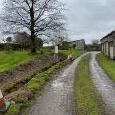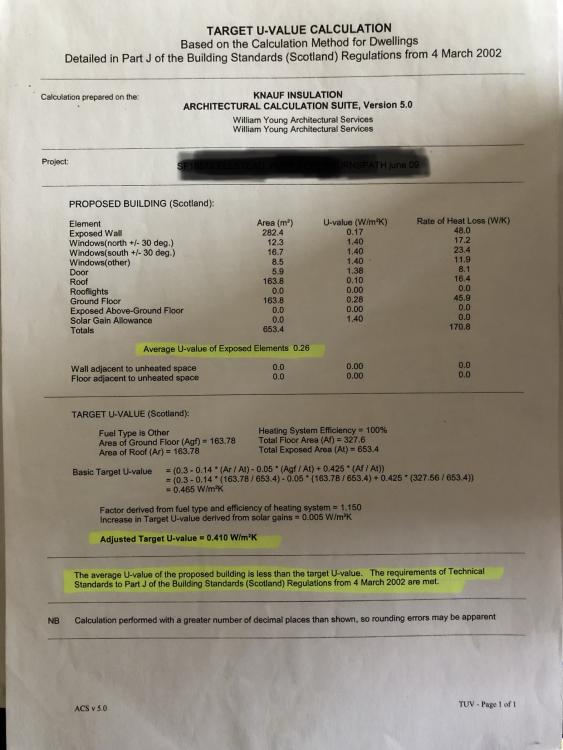Search the Community
Showing results for tags 'sap'.
-
My previous blog entry ended at submitting the building regs in March, although they were not validated until 5th April and then refused on the 31st May. I believe my architect had complained on them taking too long so I am guessing when they found he had not included a turning circle for a fire engine they refused them as giving the architect extra time would have hit their own time targets. We resubmitted 1st June and finally had approval on the 5th July. A few conditions but nothing unexpected. In the meantime we submitted our amendment to planning for our window changes this was to increase the airflow through the house to pass Part O more on this later. This was submitted to planning on the 21st March and approved on the 12th May. When the BC plans were initially refused I decided not to contact our architect as he obviously had something wrong and as it was all out of my hands, I just presumed it was not my Part O spreadsheet as he never contacted me. You can not rush anything in Cornwall it will all be dealt with dreckly, (eventually no time limit). Instead I got on with jobs I could do, mainly starting a new vegetable plot as the old one is in the way of the new build for plant access and will eventually become garden. My potting shed is only a few years old so it will be dismantled and stored indoors until we have walls and roof on and can position the shed close to the new build. My netted tunnel is also now down and will not be going back up instead I will create new smaller structures to cover individual groups of crop and re-use the larger netting just for my new strawberry beds. We have had a hosepipe ban on here in Cornwall for a year now so it’s not been a bad year to not be growing anything new and instead concentrate on the soil and new beds. Top photos are the early days of my vegplot and below as it is now, looking a bit sad but better things will come. Before it sounds like I’ve lost the plot and writing a gardening blog I’ll return to our build progress. We advertised our existing barn as free locally and received many offers to remove it. A local couple will be taking it down in October and rebuilding it on their land. I’ve sold a lot of paving that I had kept just in case we wanted it in the future but finally decided it’s not required. The problem with having land and outbuildings is it’s difficult to get rid of things we just move it to the cow shed but that has to stop. So all the wood in the old cow shed is moving to the old pig sty. We started keeping the wood because we wanted a stove but eventually decided our listed barn was never going to have a wood stove so a few trees that got cut down were given to neighbours but now the new build is going to have a wood stove so we’re saving wood again. Emptying the cow shed also involves giving away corrugated tin roof sections that have been saved just in case, moving a pile of nice small stone I was going to make a rockery with and finding a new home for our Christmas wooden reindeer. The cow shed is now nearly empty. We also hired some plant and shifted some spoil full of weeds from around the cow shed and took down two more trees, the Ash tree had Ash die back and it had been allowed to self seed much to close to the fir tree that had grown one sided. They were also in the way of the new field access that we are making wider for easier machinery access, and will also now provide a hammerhead turn for a fire engine. The spoil and tree stumps were moved to the lower field, the useable fire wood stored in the old pig sty with a few large pieces left as temporary seats for the builders. Top row left cow shed surrounded by weeds, right new wider access cow shed on the left with stables in the distance. Middle row clearing in progress and the better access. Bottom row me in the sun and heat while husband is in the Air Conditioned digger, some of the larger stone put to one side no boulders so far. We still have not got our ground-workers or builders sorted out, a few have been to look, some you never hear from again others give a quote that’s ridiculously high with so many provisions. Some will do this and that but not that, they suggest somebody else who is not interested. I think it's partly because we want an ICF build and also to dry shell stage only, excluding windows. We still hope to start next year but are now thinking to just get the groundworks completed as that is the most unknown quantity, and we are still saving up. The build is being partly funded by the sale of a Jensen FF but we have only just got round to advertising it last month and finding the right buyer could take a while. Part O Unfortunately my architect did not think ahead and design the house with Part O in mind and it took quite a while for me to work out what I had to change to pass the simplified method. A local company was approached and discussed the simplified method and the dynamic method but from what they told me there was no guarantee in passing either and to pass the dynamic method more changes to the building design and further dynamic modelling could be required so no set fee was offered. Instead I designed my own spreadsheet that initially proved our ventilation of just opening windows would not be enough to pass Part O but after reading up more and few window swapping ideas I got a pass on my own spreadsheet. I also stumbled upon the future homes site which has a spreadsheet that can be downloaded. As I’m a Apple Mac user it meant using MS Excel online but it was a far prettier version than my nuts and bolts spreadsheet and one that I thought my BC would be happier with. I input my window measurements and how they opened, and obtained a pass. Anybody reading this and wanting ideas on how to pass the simplified method first depends on what you fail on e.g. too much glazing or the free flow of ventilation although one can impact the other. I don’t think anybody looking at our plans from the first blog would think we would not pass as the southerly view is not overly glazed but by removing 3 windows on the northerly side and adding 6 roof windows that open 50 degrees and slight changes to bedroom windows meant the northerly facade was the most glazed and we had better air flow. We also changed all windows that open to open inwards to meet the arms reach criteria, enabling a wider opening. The spreadsheet is not perfect though as my bedroom windows are tilt and turn but you can only have the same hinge for day and night on the spreadsheet e.g. side hung. I could have adapted the spreadsheet but that would mean its not as trustable as I was hoping it was going to be or I could have created two one daytime side hung and one for night time opening when the windows are top hung. I decided to make the one spreadsheet work as explaining to my architect who would then have to explain to BC would be like learning and then teaching a foreign language. Happily we passed the simplified method with a condition about night time security when I get my own named BC I will be able to talk them though the spreadsheet quickly change the side hung to top hung and get a pass and if I still need a security grill it will only be for the lower half that opens at night and this can be made to measure by my talented husband out of rebar. The changes to windows did mean we had to make an amendment to the plans but as it was due to my architect not thinking ahead about the new regulations I suggested to him that I shouldn’t have to pay for this and he agreed. https://www.futurehomes.org.uk/library#Guidancetoolsandtemplates SAP When you start out on this journey there are so many new things to learn about and discover the pre build SAP being just one of them. Unfortunately this area seems controlled by a piece of software probably not much more than a spreadsheet but no free copy for us self builders to play with to see if we change x how does it effect y etc. I was in the hands of my Architect and if you haven’t worked out by now I am usually in charge of everything so taking a back seat I found very hard. The initial SAP needed a few tweaks here and there but Im happy with the result. For those of you who don’t know what one is I am attaching mine and if anybody wants to dissect it feel free to do so but the pages long report is quite boring as they all are and it comes down to insulation, air tightness and your chosen method of heating. We plan to have a minimum of 11kw of Solar on our virtually perfect south facing unshaded roof in Cornwall. This and together with an ICF build and good window air tightness with lots of added floor insulation hopefully will mean low running costs. You will not find a ASHP mentioned I’m not having one. I don’t like them for my build. I’m near the sea where everything rusts, and if I need a plumber because its broken it will be 6 weeks before one would be available who knows enough about ASHP to fix it. In the 6 years I lived in Cornwall I have seen the lack of trades people first hand in waiting for returned phone calls that never happen, quotes that take ages and waiting lists for the good people. In winter when you most need good heating then all the trades are busy working in the holiday homes out of season and are booked up. We have no mains Gas so are going to be a mainly electric home. To ride out the peaks and troughs of solar we will have as much on the roof as we can fit and rather than export to the grid we will export to our other working barn and lower some of those summer electricity costs. In winter we will have to buy some electricity but hopefully very little at peak costs. Quick guide to the SAP The first 3 pages are our planned u-values, expected Air permeability results, space heating, hot water etc and MVHR. The following 30 pages look very similar but have different headings and figures. Calculation of dwelling emissions for regulation compliance Calculation of target emissions Calculation of fabric energy efficiency Calculation of target fabric energy efficiency Calculation of energy rating Calculation of EPC costs, emissions and primary energy page 18 perhaps the one to read first Calculation of energy rating for improved dwelling Calculation of EPC costs, emissions and primary energy for improved dwelling Finally the predicted energy assessment on page 33 (96A0 and the estimated energy cost for the property over a year £103 That’s all for now, my next job is getting a full online estimate of the build now we have all the building regs and SE calculations completed. Build Costs b/f from first blog £12660 Building regs submission £345 Hired in plant and fuel £890 SAP £300 Part O Free VAT element only on building regs, and SE (Not included in first blog totals) £430 Total to date £14625 SAP.pdf Part O.xlsx
-
-
Most of us calculate Design EPC numbers using the free FSAP software from Stroma. This is a thread for help and questions, since I may be about to ask a few. Ferdinand
- 47 replies
-
Hi All Does anyone have any alternatives to kingspan that can provide psi values for a 100mm brick-100mm cavity (with 50mm insulation board) and 100 mm dense concrete block? I was first looking at QUINN/MANNOK as its about half the price, have all the relevant details except for psi values when using a 50mm insulation board. Essentially what I'm looking for is similar to the attached with a cheaper product so wondered if anyone had had any luck with this Thanks Jordan 1581676158_50mmCavityKoolthermK108(50mmin100mmcavity)StandardDetails-2ndIssueFebruary2019.pdf
- 2 replies
-
- sap
- thermail bridge
-
(and 2 more)
Tagged with:
-
We're getting an extension built over the garage to extend the living space and we're trying to optimise for natural lighting. The design introduces more than the 25% of the extended floor space in new glass so we're told by the building regs people that we need to get SAP calculations done. Can anyone advise as to what the scope of those SAP calcs should cover and do I also need a new EPC certificate or does that come with it? I don't quite understanding if the evaluation needs to be done for the entire house or limited to just the space in which we're making changes to. I want to make sure I'm asking for quotes for what I actually need.
-
Hi I think I understand how U-Values are calculated e.g. (Layer thickness) X Lambda = R in m2 K/W Add up all the R-values for each of the layers and 1/(Total R-Value) = U-Value in W/m2 K However if you look at the calculations from my "As-designed" SAP 2009 report below, the calculated Total R-Value = 5.844 m2 K/W and if you take the inverse of that the U-Value is 1/5.844 = 0.171 W/m2 K and not the 0.14 shown on the report below. Can anyone please explain how the 0.14 was achieved...what am I missing??? Thanks
- 13 replies
-
- u-value
- calculation
-
(and 3 more)
Tagged with:
-
Does anyone have a link to an idiot proof guide to help me understand my U-Value calculations, and what ‘Ok’ might look like please. I don’t have a passive house, so it won’t be super efficient, and some of the assumptions in mine aren’t quite right I believe as surely if I have MHRV it shouldn’t say ‘ventilation natural, fans 5’ ? It also doesn’t take the extension into account either. I really just would like to form view of how my house performs, and how I might be able to calculate a revised value. I doubt I can change anything at this stage. Many thanks! Summary of mine is below.
- 17 replies
-
- 1
-

-
Insulating to Min Building Regs
Ian posted a topic in Energy Efficient & Sustainable Design Concepts
I know that most people here are building homes that will far exceed the minimum standards required by Part L of the Building Regulations (Part L = conservation of fuel & power) I finished my own build about a year ago - it's a small 2 bed holiday home on a remote site in N Wales and I decided to build it to just meet the minimum standards allowable in Part L and I thought it may be useful to give those of you who are exceeding Part L requirements an example of minimum compliance for comparison purposes. It's a single storey timber frame and timber clad bungalow with a net internal area of 71 m2 and an internal heated volume of 234 m3 (we've exposed the pitch of the roof internally). It's a rectangular shape on plan as it's built along the contour of a 1:8 sloping site. (Small rectangular bungalows are about the worst shape for energy efficiency). It's heated by bulk LPG and a combi boiler. No PV or other renewables. Naturally ventilated with no MVHR. These are my SAP figures: EPC C71 [Edit to add EI Rating of B81] Averaged (area weighted) 'U' values for walls, floor and roof of 0.15 Actual 'U' values are: floor 0.1 (we have a ground bearing conc slab with Hive app controlled underfloor heating and 300mm of EPS under the concrete) walls: 0.21 (minimum allowed in Welsh regs). Roof: 0.13 Windows 3G 0.8 Air test actual figure of 3.7 m3/(h.m2) (no special tapes or air tightness layer) Energy demand figures from the SAP calculation: Heating demand 3400 kWh (this equals 47.9 kWh/sqM of internal area) Hot water: 2290 kWh Electric for pumps and fans: 120 kWh Electric for lighting: 314 kWh (all LED) Primary Energy Demand: 106.1 kWh/sqM/year [Edit to add: CO2 emissions: 1,596 kg/yr CO2 emissions: 22.49 kg/m2] The house is warm and draught free. The things I like most about it apart from the location and spectacular views are the open plan layout with tall 'cathedral' ceilings, the u/floor heating and the 3G windows. I'd be very interested in seeing comparative figures for your own builds. Ian- 26 replies
-
- 2
-

-
Am I correct in thinking that there are two SAP assesments, one prior to starting and one when actually built? Since our initial assessment, we have progressed with the build, now at second fix. Unsurprisingly we have made some changes to the original specification. We have increased the amount of glazing to a Southerly aspect, now have underfloor heating installed rather than radiators. Now looking at not installing a gas combi boiler, instead a couple of Ellis water heaters for the ufh heating and a hot water tank with an electric immersion. It is for a holiday home at present, so not going to get intensive use. Can always install the gas fired solution in the future if required. Also, owing to some project scope creep, funds are dwindling, so the log burner may not be installed as originally planned, once again maybe in the future. On the plus side I’m hoping we will be a lot more airtight that the 5 used in the original SAP. Just wondering how this is going to impact on my final SAP, do I just wait and see? Can I end up ‘failing’ ? If so what then?
-
Our provisional BC SAP came through at 101 A (6Kw of PV or 107 with the full 8Kw) which makes me very happy. However the assessor told me I could have got two more points if I didn't have the MVHR because of the energy it uses. Can't live without MVHR so was wondering what the collective experience was with SAP and MVHR, can I get a better MVHR (Unit so far in the frame is: Airflow Adroit DV145) what, I wonder, is the conversion from energy use to points (Banded / Algebraic / ?) because I am not sure I will get a much lower figure.
-
Has anyone ever done a manual SAP calculation? I have just finished it (lots or excel work that I can maintain and update) and want to make sure I have some sensible answers. Here are some key points: Total Floor Area: 414.29m2 Living Floor Area: 107.39m2 Dwelling Volume: 1077.88m3 Window Area: 50.5m2 U-values 0.8 – 1.04 (PHPP calculations) Door Area: 10.62m2 U-value 0.73 External Wall Area: 345.4m2 U-value 0.10-0.11 Roof Area: 355.8m2 U-value 0.11 Thermal Bridges: 7.85W Design 26.66W TFEE Design FEE TFEE Effective Air Change Rate: 0.15 10.23 10.52 Heat Loss Parameter: 0.508 W/m2K 9.162 W/m2K 9.563 W/m2K Water Heating required: 2837 kWh/year 2404 kWh/year 2837 kWh/year Internals and solar Gains: 1540-2711 W/month 1396-2423 W/month 1612-3322 W/month mean Internal temp: 20.22-20.49oC 13.59-14.97oC 17.76-19.02oC Space Heating required: 1.17 kWh/m2/year 11.64 kWh/m2/year 11.94 kWh/m2/year Space cooling required: 0.64 kWh/m2/year 0.06 kWh/m2/year 0.04 kWh/m2/year Giving a Fabric Energy Efficiency of: 1.81 kWh/m2/year Design 11.70 kWh/m2/year FEE 13.77 kWh/m2/year TFEE So my designed Fabric Energy Efficiency is far better than the notional Dwelling Fabric Energy Efficiency Rate let alone the Target Fabric Efficiency rate, so I am ok there. On CO2 emissions the Target Emission Rate is 7.37 and the Design is -1.11 or -1.89 depending on how I calculate the DHW, so again well under. So my calculated ratings are SAP A (100-102), CO2 A (101-103) and Primary Energy A (109-115). The variation is based on DHW higher figure for pure Gas DHW, the lower if is assume half provided by ASHP pre-heat (but I will have to get authorisation for that). Is this the sort of answers I should be getting?
-
I'm ploughing through the final bits for submission of BRegs and I've come across an interesting query.... The build being undertaken is listed as a Conversion and Extension on the planning application, and is effectively the conversion of a large 28sqm footprint double garage, and adding on two extensions of around 30sqm and 45sqm respectively. As its listed as a conversion, and to all intents and purposes the walls will remain from the old garage (it was built for the purpose of conversion in 1992) then its questionable as to whether it needs to follow L1B or L1A. If I read the terms in L1A then the creation of the house from the garage constitutes a material change of use as per the definition. If that is the case, I assuming all of the DER, TER, SAP and Pressure testing goes out of the window and basically I'm on best endeavours in relation to meeting the regs on an elemental method..?? Does that sound reasonable or have I missed something..??!!
- 7 replies
-
- building regulations
- sap
-
(and 1 more)
Tagged with:









